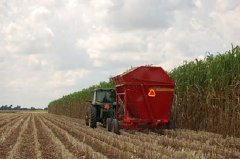Nov 6 2007
 Texas A&M University
Texas A&M UniversityResearchers have been studying fuels from biomass for years. Now, with growing dependency on foreign oils and an energy-conscious society emerging, biofuels are fast becoming part of a fuel revolution that could reach pumps all across America.
Ethanol blends are already available at some gas stations. However, their availability varies from state to state, depending on the volume of ethanol produced. Sources of biomass for biofuel production in each state also vary widely.
“To see it everywhere, we have to make more of it on a regional basis,” says Dr. Bill Rooney, professor, Plant Breeding and Genetics, Soil & Crop Sciences Department, Texas A&M University. “The best source for biofuel in a region is contingent on the environment, growing season, water and fertility availability, stress resistance, and processing and conversion techniques. In any location, there will be several species grown for biomass.”
Approximately 20 percent of grain sorghum is now used for ethanol production. Rooney is currently developing sorghum varieties specifically for bioenergy. He will discuss this topic on Wed., Nov. 7 during his talk, “Sorghum Breeding for Bioenergy Traits,” at the Annual Meetings of the American Society of Agronomy (ASA), Crop Science Society of America
(CSSA) and Soil Science Society of America (SSSA). He will speak at 2:30 pm during the symposium “Breeding and Genomics of Crops for Bioenergy” at the Ernest N. Morial Convention Center, Room 207.
Another presentation related to biofuels, “Sweet Fuel for the U.S.”, will be given by Dr. Jorge Da Silva, associate professor, Molecular Genetics and Plant Breeding, Soil & Crop Sciences Department, Texas A&M University, on Tues., Nov. 6 at 10:15 am. His presentation will be during the symposium “Agronomic Aspects of Biofuel Crop Production” in Room 214 of the Convention Center.
“Production of energy, such as ethanol, from sugar is more efficient than production from grains in both cost per unit and energy efficiency,” Da Silva says. “Sugarcane is ranked first among all other crops for biomass production and can be a key component of biomass supply. Technology for producing ethanol from sugarcane is well established in tropical countries such as Brazil, where energy independence has been achieved.”
Although there is no finite development timeline, there is clearly a race for biofuels as the cost of petroleum reaches previously unimaginable levels, reserves diminish, and environmental concerns soar. If won, this race could bring about a revolution as significant as Henry Ford’s creation of the Model T car.
The ASA-CSSA-SSSA annual meetings will be Nov. 4-8 at the Ernest N. Morial Convention Center in New Orleans. More than 4,000 scientists and professionals from around the world will attend research presentations on climate change, urban planning, crop production, hazardous waste, human health, bioenergy and more.